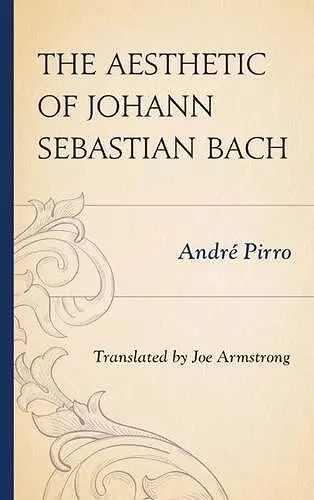The Aesthetic of Johann Sebastian Bach
Andre Pirro author Joe Armstrong translator
Format:Hardback
Publisher:Rowman & Littlefield
Published:20th Jun '14
Currently unavailable, our supplier has not provided us a restock date

The Aesthetic of Johann Sebastian Bach (L’Esthéthique de Jean-Sébastien Bach), by the celebrated French musicologist André Pirro (1869‒1943), was originally published in 1907 and reissued in 1973. It is offered here for the first time in English, as translated by Joe Armstrong. Pirro’s work is based primarily on an examination of the close relationships between language and music in Bach’s vocal works and provides us with an extensive and well-researched “lexicon” of the expressive resources of Bach and his contemporaries. Pirro’s study thus serves as a still sound basis for understanding and interpreting Bach’s instrumental works. Pirro’s engaging analysis that has informed and even moved discerning readers for more than a century. This translation introduces his work to a new audience of performers, music teachers and their students, composers, musicologists, and all who wish to have a greater understanding of the expressive import of Bach’s music.
André Pirro’s classic, The Aesthetic of Johann Sebastian Bach brings to life the aesthetic of the master who changed all music since Palestrina, creating a German Renaissance that paved the way for Ludwig Van Beethoven and Richard Wagner. But this book is a triumph not only for its author, but for Joe Armstrong, the man who brings to this translation a nuanced of Mr. Pirro’s subtle rhythms and cadences together in a book of great technicality and breathtakingly beautiful prose. . . .This new edition of an old classic is as precious to appreciators of music (of every hue) and its creators as well as to those who would like to learn about perhaps one of the greatest musicians of all time: Johann Sebastian Bach. The fact that it has only been reprinted twice—first I 1973 and now in 2014; the only edition since its illustrious debut in 1907—is perhaps the greatest cause for celebration for it will not only revive interest in Bach, but will create a fresh era for the study of Bach’s music. Its twelve chapters constitute a most extraordinary thesis. . . .The work . . . remains a work of exciting narrative—written as if it were a great Father Brown detective novel. It is a book written as much in praise of the Master as it is an attempt to arrive at the very essence of Bach—his personality and being—as it is one that sets out to, and arrives at his aesthetic with near pinpoint accuracy. . . .This book, like literary classics, captures and articulates passions and urges, aspirations, joys and anguish that are shared by all individuals no matter where they live and what language they speak. * World Music Report *
This book is a triumph not only for its author, but for Joe Armstrong, the man who brings to this translation a nuanced sense of rhythm that captures Mr. Pirro’s subtle cadences in a book of great technicality and breathtakingly beautiful prose. This new edition of an old classic is as precious to appreciators of music (of every hue) and its creators as well as to those who would like to learn about perhaps one of the greatest musicians of all time: Johann Sebastian Bach. The fact that it has only been reprinted twice—first in 1973 and now in 2014; the only edition since its illustrious debut in 1907—is perhaps the greatest cause for celebration for it will not only revive interest in Bach (as if there was ever a need to “revive” interest in his aesthetic), but will create a fresh era for the study of Bach’s music. . . .This book, like literary classics, captures and articulates passions and urges, aspirations, joys and anguish that are shared by all individuals no matter where they live and what language they speak. * Jazz da Gama *
This new translation of Pirro's work offers a valuable glimpse into the musical thought of the early twentieth century, wherein we see the rigor of systematic procedure, the strong claims of universality, and a robust privileging of the emotional content of Bach's works.... [It is] especially welcome ... in bringing an important historical document back into view.... Pirro's work is a reminder of the substantial debt we owe to this generation of Bach scholars. And in its day, the novelty of views now so familiar surely heightened the influence and impact of this work. If today we turn to it more with a historiographic eye, we nevertheless recognize in its pages a passionate engagement of the subject at hand. We are in Joe Armstrong's debt doe allowing us to savor this engagement anew and with ease. * BACH: Journal of the Riemenschneider Bach Institute *
This English translation of Andre Pirro’s The Aesthetic of Johann Sebastian Bach is a significant volume of the music and aesthetic of J.S. Bach…. The author takes a deep look at the texts of many of the works examined, making the volume of special interest to vocal teachers…. The book is of special value to classical musicians but can also enlighten present-day composers, especially in the areas of counterpoint and text use. I give this book an A+ for both relevance and importance to the music education field. The Aesthetic of Johann Sebastian Bach is a must-purchase for research libraries for use by scholars. Its genius is that it is also very readable for the classroom music educators, to whom I highly recommend the book. * Music Educators Journal *
ISBN: 9781442232907
Dimensions: 237mm x 161mm x 42mm
Weight: 889g
518 pages